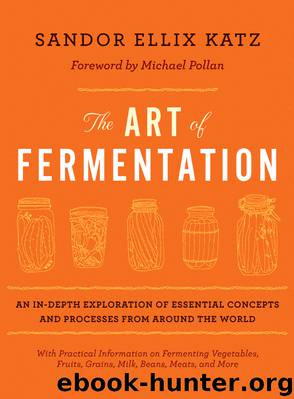The Art of Fermentation: An In-Depth Exploration of Essential Concepts and Processes from Around the World by Katz Sandor Ellix

Author:Katz, Sandor Ellix [Katz, Sandor Ellix]
Language: eng
Format: epub
Publisher: Chelsea Green Publishing
Published: 2012-05-14T22:00:00+00:00
Poi
Poi is a Hawaiian ferment of taro (Colocasia esculenta) mashed into a gluey purple paste. Taro is central and sacred to the native people of Hawai’i, who call it kalo. Poi made an impression on Captain James Cook, who described it in his earliest report from Hawai’i: “The only artificial dish we met with was a taro pudding; which, though a disagreeable mess from its sourness, was greedily devoured by the natives.”38 By 1933, a University of Hawai’i study reported that “other foods are taking the place of this ancient standby.”39 Nevertheless, poi has endured. “As Hawaiian culture and language continue their steady resurgence begun in the 1970s, an awareness of the importance of kalo is reemerging as well,” reported Maui Magazine in 2007.40
The part of the taro plant processed into poi is the swollen underground base of the stem, known as the corm. The taro corm must be thoroughly cooked by steaming or boiling in order to neutralize calcium oxalate crystals, “which feel like eating fiberglass” if consumed uncooked, reports my friend Jay Bost. Once cooked, the corm’s skin is scraped off and, while still warm, the starchy flesh is mashed into a paste, adding water as necessary. Traditionally, the cooked taro is mashed against a special wooden board using a heavy stone pounding tool, known as a pohaku ku‘i ‘ai. You can mash by hand, using either a mortar and pestle or a potato masher, or in a food processor. Try to find and crush any lumps, in order to get the paste as smooth as possible.
To ferment, simply pack the mashed taro into a ceramic or glass bowl or crock. Leave some room in the vessel for expansion, as the poi will expand as it ferments. Ferment it for a few days at room temperature. Typically no culture is introduced, unless you have mature poi, a little of which can be added to the fresh mashed taro. If white surface mold develops, mix it right in.
It remains a bit of a mystery to me how the ferment starts so quickly in a cooked substrate without adding any raw adjuncts to get it going; however, somehow it does. Two bacteriologists at the University of Hawai’i published a five-year study of poi fermentation in 1933. They performed bacterial cell counts on uncooked taro corms, on the skins immediately after cooking, on peeled cooked taro, and on fermented poi. “The organisms responsible for the fermentation were abundant on the steamed taro corms immediately following heating,” they reported. “Grinding of the crushed corms aids in breaking the bacterial clumps or colonies on the corms, and therefore makes possible not only increase in numbers of organisms, but also their distribution rather homogeneously throughout the fresh poi.”41
As with any ferment, some people prefer poi mild after just a day or two, while others prefer the more sour flavor that develops as more days pass. In Hawaiian temperatures, three to five days is the normal range; in cooler places, it may take longer. The color and texture of the poi also change as fermentation proceeds.
Download
This site does not store any files on its server. We only index and link to content provided by other sites. Please contact the content providers to delete copyright contents if any and email us, we'll remove relevant links or contents immediately.
Periodization Training for Sports by Tudor Bompa(8168)
The Body: A Guide for Occupants by Bill Bryson(4973)
The MacArthur Bible Commentary by John MacArthur(4746)
The Sports Rules Book by Human Kinetics(4288)
What It Really Takes to Get Into Ivy League and Other Highly Selective Colleges by Hughes Chuck(3695)
Marijuana Grower's Handbook by Ed Rosenthal(3619)
The Sprouting Book by Ann Wigmore(3543)
The Martian by Andy Weir(3302)
Salt, Fat, Acid, Heat: Mastering the Elements of Good Cooking by Nosrat Samin(3106)
The Bread Bible by Rose Levy Beranbaum(3002)
Harry Potter 4 - Harry Potter and The Goblet of Fire by J.K.Rowling(2984)
Sapiens and Homo Deus by Yuval Noah Harari(2982)
The Marketing Plan Handbook: Develop Big-Picture Marketing Plans for Pennies on the Dollar by Robert W. Bly(2975)
Classic by Mary Berry(2940)
Martha Stewart's Baking Handbook by Martha Stewart(2794)
Screenplay: The Foundations of Screenwriting by Syd Field(2572)
The Plant Paradox by Dr. Steven R. Gundry M.D(2543)
50 Economics Classics by Tom Butler-Bowdon(2523)
The Cambridge Grammar Of The English Language by Rodney Huddleston Geoffrey K. Pullum(2380)
